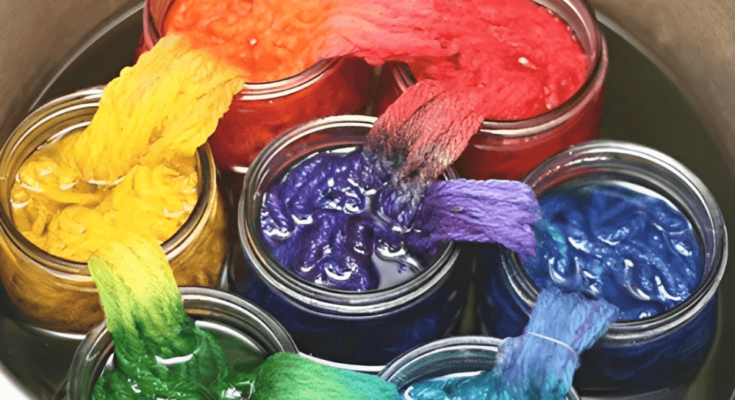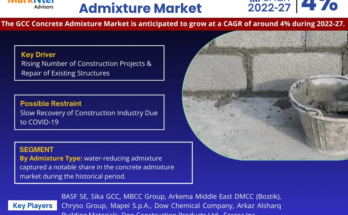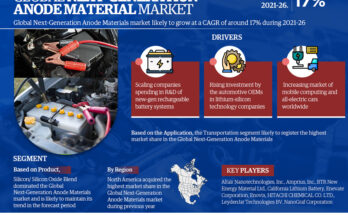Global Textile Dyes Market has valued at USD10.26 billion in 2022 and is anticipated to project robust growth in the forecast period with a CAGR of 4.54% through 2028. Textile dyes serve as coloring agents or pigments to impart specific aesthetics to textiles. Various fabrics, such as denim, polyester, wool, cotton, acrylics, fur, nylon, silk, and others, undergo dyeing processes to achieve desired hues. Dyes are textile colorants obtained through chemical mixtures, carefully formulated to achieve the intended shades. The types of dyes commonly employed in textile dyeing include direct, reactive, VAT, basic, acid, and disperse dyes. Textile dyes are widely recognized as a dyeing method that involves the use of textile materials such as fabrics, yarns, and fibers. It entails the application of specialized dye solutions and chemical substances, employing various dyeing techniques including semi-continuous, continuous, and batch processes. Textile dyes find extensive application across diverse industries, particularly in the production of fabrics, clothing, and loose fibers through yarn preparation. The progressive advancements in the textile dyes industry play a pivotal role in propelling market growth. Moreover, the surging demand for colored textiles and fibers, substantial research and development investments in plant-based dyes, and the cost-effective manufacturing capabilities in APAC countries are anticipated to further drive the expansion of the textile dyes market.
Key Market Drivers
Growth in Technological Advancements and Innovation
As consumer demands shift towards sustainability, customization, and performance, the textile dyes market is adapting to these changes through cutting-edge technologies that enhance color vibrancy and revolutionize the dyeing process. In this dynamic landscape, technological progress and innovation have emerged as powerful drivers propelling the global textile dyes market towards an exciting and sustainable future. Innovations like digital printing and waterless dyeing significantly reduce water consumption and chemical waste, contributing to a more environmentally friendly industry. For example, digital printing eliminates excessive water and energy usage by directly applying color to textiles, reducing the carbon footprint, and enabling on-demand printing to minimize overproduction and wastage. Similarly, waterless dyeing technologies utilize supercritical carbon dioxide or other innovative methods to achieve vibrant colors without excessive water usage. The rise of smart textiles has prompted the development of dyes that can respond to external stimuli such as temperature, light, or pH levels. These dyes, known as chromic dyes, find applications in sectors like sports, healthcare, and even military clothing. For instance, thermochromic dyes change color in response to temperature fluctuations, allowing sportswear to visually indicate body heat levels during workouts. Photochromic dyes react to UV light, providing sun-sensitive clothing that changes color as a reminder to reapply sunscreen.
This fusion of function and fashion enhances user experiences and expands the boundaries of textile applications. Nanotechnology, with its ability to manipulate materials at the molecular and atomic scale, is making a significant impact on the textile dyes market. Nanoparticles are being integrated into dye formulations to achieve enhanced properties such as color fastness, antimicrobial capabilities, and UV protection. Nanoparticles improve dye penetration and adherence to textiles, resulting in longer-lasting and more vibrant colors. Additionally, antimicrobial nanoparticles create textiles that inhibit the growth of bacteria and fungi, making them suitable for medical and sports applications. Exploiting the potential of nanotechnology, the global textile dyes market is poised for a technologically advanced and innovative future. Innovation in the textile dyes market is intrinsically tied to sustainability.
With increased consumer awareness about environmental and ethical concerns, manufacturers are aligning their efforts with eco-friendly practices. Technological advancements have enabled the creation of biodegradable dyes, natural dyeing processes using plant-based materials, and the extraction of pigments from agricultural waste. By incorporating sustainability into their products, textile dye manufacturers meet consumer demands and contribute to a greener future for the industry. Eco-friendly innovations are not merely trends; they are becoming the foundation of textile dyeing practices. As consumer preferences evolve and sustainability becomes paramount, the marriage of technology and innovation weaves a story of growth, creativity, and environmental consciousness in the global textile dyes market.
Download FREE Sample Report @ https://www.techsciresearch.com/sample-report.aspx?cid=2594
Increasing Demand of Non-Woven Fabrics in the Healthcare Industry
In recent years, the global textile industry has experienced a notable shift in demand dynamics, primarily driven by the healthcare sector’s increasing reliance on non-woven fabrics. Non-woven fabrics have emerged as a transformative element in the healthcare industry due to their remarkable attributes such as softness, flexibility, and absorbency. These textiles find diverse applications in healthcare settings, encompassing surgical gowns, drapes, wound dressings, face masks, and even filtration media. Their ability to provide a physical barrier, aid in infection prevention, and enhance patient comfort has rendered them indispensable in modern healthcare practices. Healthcare textiles necessitate more than just aesthetic appeal; they require functional properties as well. For instance, surgical drapes and gowns must endure repeated washing and sterilization processes while preserving their color and performance. Textile dyes that offer excellent color retention and resilience in the face of harsh treatments play a pivotal role in meeting these demands. The development of dyes that are both vibrant and durable is therefore imperative to support the evolving landscape of healthcare textiles. Dyes utilized in medical textiles must be non-toxic, hypoallergenic, and devoid of harmful substances that could compromise patient health. In response, the textile dyes market has directed its focus towards developing dyes that not only exhibit vibrancy but are also safe for skin contact, making them suitable for healthcare applications. Non-woven fabrics employed in healthcare often require specific color codes for differentiation and branding. Consequently, dyes capable of reproducing consistent shades and meeting precise color specifications are indispensable for maintaining uniformity in medical textiles. Textile dyes equipped to provide a wide range of colors while ensuring color consistency effectively support the customization needs of healthcare facilities. The demand for textiles with antimicrobial properties has surged in light of increased awareness about infection control. Innovations in textile dyes that incorporate antimicrobial agents directly into the dyeing process have resulted in the creation of textiles with built-in protection against microbes. Such innovations align with the healthcare sector’s emphasis on infection prevention and contribute to the growing demand for specialized medical textiles. Moreover, as healthcare continues to drive textile innovation, the textile dyes market will remain crucial in supporting the transformation of non-woven fabrics into indispensable tools for modern medical practices.
Key Market Challenges
Strict Regulations and Standards
The global textile dyes market plays a crucial role in the fashion and textile industry, providing an array of vibrant colors and intricate designs that embellish our everyday fabrics. However, as global awareness grows regarding environmental and health issues, the textile dyes market faces significant challenges in the form of stringent regulations and standards. In recent years, regulations governing textile dyes have rapidly evolved due to mounting concerns about the environmental and health impacts of dyeing processes. Textile dyes have the potential to leach into water bodies, causing pollution and posing a threat to aquatic ecosystems. Moreover, certain dyes contain hazardous chemicals that can be detrimental to both manufacturing workers and end consumers. Consequently, governments and international organizations have implemented rigorous regulations and standards to address these concerns. Another noteworthy challenge brought about by strict regulations is the imperative to ensure the safety and well-being of workers involved in the dyeing process. Some dyes contain toxic substances that can have adverse effects on human health. Manufacturers must, therefore, implement stringent safety measures to protect their workers, which can result in increased costs and operational complexities. Furthermore, meeting health and safety standards may lead to a reduced selection of available dyes, thereby limiting creative options for designers and potentially impacting the final product’s quality. Strict regulations and standards can also introduce complexities within the global textile dyes supply chain. Manufacturers and suppliers must ensure that the dyes they produce, or source comply with the regulations of the various countries to which they export. This necessitates comprehensive knowledge of different regulatory frameworks and the ability to adapt quickly to changes.
Key Market Trends
Digital Printing and Customization
In recent years, the global textile dyes market has experienced significant transformations, driven by the emergence of digital printing and customization as influential trends that reshape the industry. Digital printing has revolutionized the textile sector by enabling unparalleled levels of creativity, speed, and cost-effectiveness. Unlike conventional methods, digital printing allows for small production runs, reducing waste and excess inventory. This flexibility has paved the way for on-demand manufacturing, where textiles can be produced based on real-time demand, thus minimizing environmental impact. One of the key advantages of digital printing is its ability to achieve vibrant and intricate designs without the need for complex pre-treatment processes. Through the use of specialized inks and advanced color management software, consistent and accurate color reproduction is ensured. This aspect holds particular significance in industries like fashion, where color accuracy and consistency are of paramount importance. In the era of personalization, consumers are increasingly seeking products that align with their individual tastes and preferences. This growing desire for uniqueness has fueled the rise of customization within the textile industry. From tailor-made garments to personalized home textiles, consumers are actively searching for ways to express their identity through their choices. Digital printing technology has played a pivotal role in facilitating this shift towards customization by offering the means to create one-of-a-kind designs quickly and cost-effectively. Brands can now provide consumers with the opportunity to personalize fabric patterns, colors, and even textures, fostering a deeper connection between the product and its owner. This not only enhances customer satisfaction but also unlocks new avenues for revenue generation.
Segmental Insights
Dye Type Insights
In 2022, the Textile Dyes market was dominated by the Synthetic and is predicted to continue expanding over the coming years. Synthetic dyes are typically more economically viable to produce in comparison to natural dyes. They can be synthesized in larger quantities and with greater consistency, resulting in economies of scale that render them more financially accessible for manufacturers. This cost advantage proves critical in industries that necessitate substantial volumes of dyes, such as textiles.
Fibre Type Insights
In 2022, the Textile Dyes market was dominated by Acrylic and is predicted to continue expanding over the coming years. Acrylic fibers can readily be combined with other fibers, such as wool or cotton, to augment qualities like durability, color retention, and softness. This inherent versatility empowers manufacturers to fabricate textiles that fulfill precise performance and aesthetic criteria.
Related Reports
Hydrocolloids Market [2028] – Report & Market Share
Ink Additives Market [2028] – Forecast & Projected Growth
Table of Content-Textile Dyes Market
- Product Overview
1.1. Market Definition
1.2. Scope of the Market
1.2.1. Markets Covered
1.2.2. Years Considered for Study
1.2.3. Key Market Segmentations
- Research Methodology
2.1. Objective of the Study
2.2. Baseline Methodology
2.3. Key Industry Partners
2.4. Major Association and Secondary Sources
2.5. Forecasting Methodology
2.6. Data Triangulation & Validation
2.7. Assumptions and Limitations
- Executive Summary
3.1. Overview of the Market
3.2. Overview of Key Market Segmentations
3.3. Overview of Key Market Players
3.4. Overview of Key Regions/Countries
3.5. Overview of Market Drivers, Challenges, Trends
- Voice of Customer
- Pricing Analysis
- Global Textile Dyes Market Outlook
6.1. Market Size & Forecast
6.1.1. By Value & Volume
6.2. Market Share & Forecast
6.2.1. By Dye Type (Cellulose, Protein, Synthetic and Others)
6.2.2. By Fibre Type (Wool, Nylon, Viscose, Polyester, Acrylic and Others)
6.2.3. By Company (2022)
6.2.4. By Region
6.3. Market Map
- North America Textile Dyes Market Outlook
7.1. Market Size & Forecast
7.1.1. By Value & Volume
7.2. Market Share & Forecast
7.2.1. By Dye Type
7.2.2. By Fibre Type
7.2.3. By Country
7.3. North America: Country Analysis
7.3.1. United States Textile Dyes Market Outlook
7.3.1.1. Market Size & Forecast
7.3.1.1.1. By Value & Volume
7.3.1.2. Market Share & Forecast
7.3.1.2.1. By Dye Type
7.3.1.2.2. By Fibre Type
7.3.2. Mexico Textile Dyes Market Outlook
7.3.2.1. Market Size & Forecast
7.3.2.1.1. By Value & Volume
7.3.2.2. Market Share & Forecast
7.3.2.2.1. By Dye Type
7.3.2.2.2. By Fibre Type
7.3.3. Canada Textile Dyes Market Outlook
7.3.3.1. Market Size & Forecast
7.3.3.1.1. By Value & Volume
7.3.3.2. Market Share & Forecast
7.3.3.2.1. By Dye Type
7.3.3.2.2. By Fibre Type
- Europe Textile Dyes Market Outlook
8.1. Market Size & Forecast
8.1.1. By Value & Volume
8.2. Market Share & Forecast
8.2.1. By Dye Type
8.2.2. By Fibre Type
8.2.3. By Country
8.3. Europe: Country Analysis
8.3.1. France Textile Dyes Market Outlook
8.3.1.1. Market Size & Forecast
8.3.1.1.1. By Value & Volume
8.3.1.2. Market Share & Forecast
8.3.1.2.1. By Dye Type
8.3.1.2.2. By Fibre Type
8.3.2. Germany Textile Dyes Market Outlook
8.3.2.1. Market Size & Forecast
8.3.2.1.1. By Value & Volume
8.3.2.2. Market Share & Forecast
8.3.2.2.1. By Dye Type
8.3.2.2.2. By Fibre Type
8.3.3. United Kingdom Textile Dyes Market Outlook
8.3.3.1. Market Size & Forecast
8.3.3.1.1. By Value & Volume
8.3.3.2. Market Share & Forecast
8.3.3.2.1. By Dye Type
8.3.3.2.2. By Fibre Type
8.3.4. Italy Textile Dyes Market Outlook
8.3.4.1. Market Size & Forecast
8.3.4.1.1. By Value & Volume
8.3.4.2. Market Share & Forecast
8.3.4.2.1. By Dye Type
8.3.4.2.2. By Fibre Type
8.3.5. Spain Textile Dyes Market Outlook
8.3.5.1. Market Size & Forecast
8.3.5.1.1. By Value & Volume
8.3.5.2. Market Share & Forecast
8.3.5.2.1. By Dye Type
8.3.5.2.2. By Fibre Type
- Asia-Pacific Textile Dyes Market Outlook
9.1. Market Size & Forecast
9.1.1. By Value & Volume
9.2. Market Share & Forecast
9.2.1. By Dye Type
9.2.2. By Fibre Type
9.2.3. By Country
9.3. Asia-Pacific: Country Analysis
9.3.1. China Textile Dyes Market Outlook
9.3.1.1. Market Size & Forecast
9.3.1.1.1. By Value & Volume
9.3.1.2. Market Share & Forecast
9.3.1.2.1. By Dye Type
9.3.1.2.2. By Fibre Type
9.3.2. India Textile Dyes Market Outlook
9.3.2.1. Market Size & Forecast
9.3.2.1.1. By Value & Volume
9.3.2.2. Market Share & Forecast
9.3.2.2.1. By Dye Type
9.3.2.2.2. By Fibre Type
9.3.3. South Korea Textile Dyes Market Outlook
9.3.3.1. Market Size & Forecast
9.3.3.1.1. By Value & Volume
9.3.3.2. Market Share & Forecast
9.3.3.2.1. By Dye Type
9.3.3.2.2. By Fibre Type
9.3.4. Japan Textile Dyes Market Outlook
9.3.4.1. Market Size & Forecast
9.3.4.1.1. By Value & Volume
9.3.4.2. Market Share & Forecast
9.3.4.2.1. By Dye Type
9.3.4.2.2. By Fibre Type
9.3.5. Australia Textile Dyes Market Outlook
9.3.5.1. Market Size & Forecast
9.3.5.1.1. By Value & Volume
9.3.5.2. Market Share & Forecast
9.3.5.2.1. By Dye Type
9.3.5.2.2. By Fibre Type
- South America Textile Dyes Market Outlook
10.1. Market Size & Forecast
10.1.1. By Value & Volume
10.2. Market Share & Forecast
10.2.1. By Dye Type
10.2.2. By Fibre Type
10.2.3. By Country
10.3. South America: Country Analysis
10.3.1. Brazil Textile Dyes Market Outlook
10.3.1.1. Market Size & Forecast
10.3.1.1.1. By Value & Volume
10.3.1.2. Market Share & Forecast
10.3.1.2.1. By Dye Type
10.3.1.2.2. By Fibre Type
10.3.2. Argentina Textile Dyes Market Outlook
10.3.2.1. Market Size & Forecast
10.3.2.1.1. By Value & Volume
10.3.2.2. Market Share & Forecast
10.3.2.2.1. By Dye Type
10.3.2.2.2. By Fibre Type
10.3.3. Colombia Textile Dyes Market Outlook
10.3.3.1. Market Size & Forecast
10.3.3.1.1. By Value & Volume
10.3.3.2. Market Share & Forecast
10.3.3.2.1. By Dye Type
10.3.3.2.2. By Fibre Type



